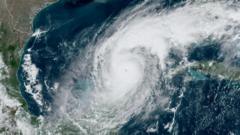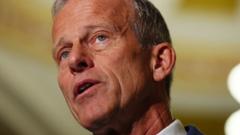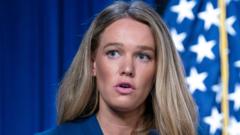The National Oceanic and Atmospheric Administration (NOAA) predicts an uptick in hurricane activity this season, raising alarms over staff reductions' impact on forecasting.
**Increased Hurricane Activity Predicted Amid Staffing Concerns at NOAA**

**Increased Hurricane Activity Predicted Amid Staffing Concerns at NOAA**
Forecasters warn of a busy hurricane season as budget cuts threaten vital research and weather tracking capabilities.
The upcoming Atlantic hurricane season, spanning from June to November, is projected to see between six and ten hurricanes, as indicated by forecasts from the National Oceanic and Atmospheric Administration (NOAA). This is an increase from the typical seven hurricanes, driven by warmer sea temperatures attributed to climate change and favorable atmospheric conditions. This year's forecast includes between 13 and 19 named tropical storms, with three to five anticipated to reach major hurricane status of Category 3 or higher.
The forecast comes amidst concerns about the impact of staffing cuts within NOAA following decisions made during President Trump's administration. Reports from scientists suggest that the layoffs have left the National Weather Service, NOAA's hazard-warning division, significantly understaffed as it heads into the crucial hurricane season. Experts fear that fewer analysts and meteorologists could hinder efforts to predict storm paths and intensity accurately.
Colorado State University researcher Phil Klotzbach has echoed these sentiments, stressing that the reduced staff will result in increased workloads for remaining personnel, which could lead to forecasting burnout. This issue is particularly pressing in regions like Texas, which faces strong hurricane threats. The local NOAA office in Houston is reportedly lacking management support, further complicating the forecasting process.
In addition to forecasting woes, cuts could threaten “hurricane hunter” missions, necessary flights that gather crucial data from within developing storms. A shortage of observations, particularly aerial data from weather balloons, is also feared, with the Trump administration allegedly downplaying climate-related initiatives.
Matt Lanza, a meteorologist based in Houston, related the quality of hurricane forecasting to data availability, noting that a lack of comprehensive atmospheric measurements could detrimentally affect prediction accuracy. The effects of NOAA's budget cuts may not be immediately observable but could lead to broader implications for global weather forecasting—an interconnected ecosystem requiring data from around the world.
In a press briefing, NOAA's acting administrator Laura Grimm defended the agency’s capabilities, asserting that they remain committed to public safety and maintaining robust forecasting, despite the challenges posed by less manpower.
Overall, the dual issues of projected hurricane activity and NOAA's operational limitations present a concerning outlook for the upcoming season. Experts urge immediate action to address staffing shortages to mitigate potential loss of life and property during severe weather events ahead.
The forecast comes amidst concerns about the impact of staffing cuts within NOAA following decisions made during President Trump's administration. Reports from scientists suggest that the layoffs have left the National Weather Service, NOAA's hazard-warning division, significantly understaffed as it heads into the crucial hurricane season. Experts fear that fewer analysts and meteorologists could hinder efforts to predict storm paths and intensity accurately.
Colorado State University researcher Phil Klotzbach has echoed these sentiments, stressing that the reduced staff will result in increased workloads for remaining personnel, which could lead to forecasting burnout. This issue is particularly pressing in regions like Texas, which faces strong hurricane threats. The local NOAA office in Houston is reportedly lacking management support, further complicating the forecasting process.
In addition to forecasting woes, cuts could threaten “hurricane hunter” missions, necessary flights that gather crucial data from within developing storms. A shortage of observations, particularly aerial data from weather balloons, is also feared, with the Trump administration allegedly downplaying climate-related initiatives.
Matt Lanza, a meteorologist based in Houston, related the quality of hurricane forecasting to data availability, noting that a lack of comprehensive atmospheric measurements could detrimentally affect prediction accuracy. The effects of NOAA's budget cuts may not be immediately observable but could lead to broader implications for global weather forecasting—an interconnected ecosystem requiring data from around the world.
In a press briefing, NOAA's acting administrator Laura Grimm defended the agency’s capabilities, asserting that they remain committed to public safety and maintaining robust forecasting, despite the challenges posed by less manpower.
Overall, the dual issues of projected hurricane activity and NOAA's operational limitations present a concerning outlook for the upcoming season. Experts urge immediate action to address staffing shortages to mitigate potential loss of life and property during severe weather events ahead.





















